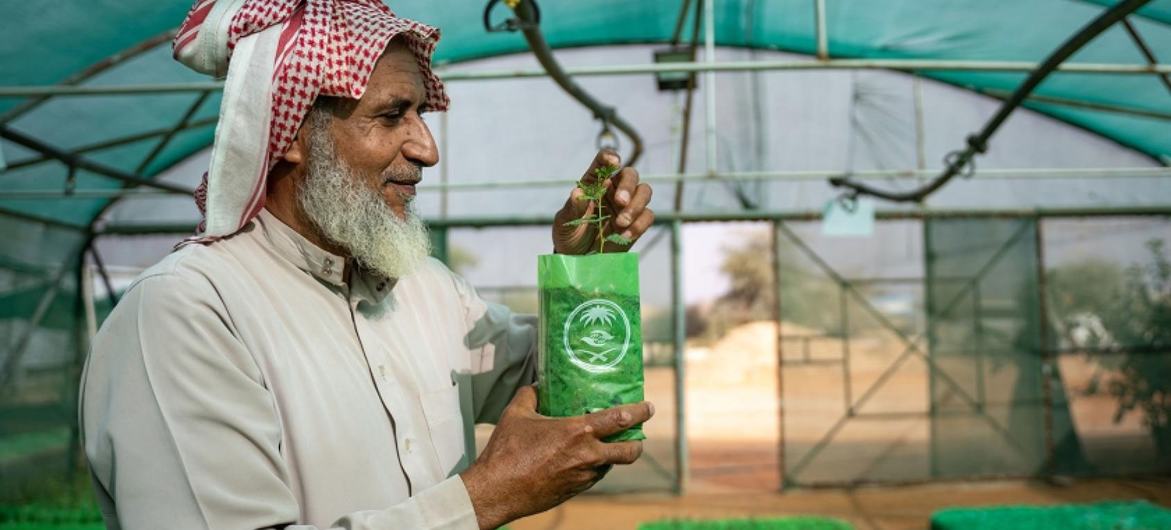Throughout the world, people of all ages are responding to this threat by adopting new methods of working on the land that could not only prevent further degradation but also create new job opportunities.
The issue of desertification, drought, and land restoration is being discussed at a global meeting of the UN Convention to Combat Desertification (UNCCD), currently taking place in Riyadh, Saudi Arabia, until 13 December.
UN News/Daniel Dickinson
Communities in southern Madagascar are planting sisal to protect the land from erosion and degradation.
Drawing a line in the sand in Madagascar
In southern Madagascar, productive land is disappearing rapidly due to sand blowing across farmland driven by strong seasonal winds.
These communities are among the most vulnerable in Madagascar, and as their sandy soils degrade further, they face a threat to their livelihoods and ability to cultivate the land.
With support from the UN, communities have started growing sisal plants, which are resilient to harsh conditions and well-suited to arid environments.
When planted in a grid pattern, they can help stabilize the topsoil and prevent erosion, leading to fewer sandstorms and more opportunities for agriculture.
“Previously, this land was just sand, and we couldn’t grow anything. But now, with sisal planting, the village has benefitted,” said Lydia Monique Anjarasoa.
Listen to The Lid is On podcast from UN News to learn more about how communities are resisting change caused by winds.

© UNEP/Duncan Moore
Thadiq National Park manager Abdullah Ibrahim Alissa surveys saplings at a tree nursery in a desert area of central Saudi Arabia.
Regreening the desert in Saudi Arabia
In Saudi Arabia, Abdullah Ibrahim Alissa explained the degradation and desertification of the arid land north of Riyadh, the country’s capital, where he grew up.
This land falls within the rocky Thadiq National Park, famous for its expansive valleys. As the current manager, Mr. Alissa launched a project to revitalize the 660-square-kilometer park by planting 250,000 trees and one million shrubs, along with constructing terraced dams to capture the region’s scarce rainwater.
“Through afforestation projects and care, the area has undergone a complete transformation,” said Mr. Alissa.
Restoring Thadiq National Park is part of Saudi Arabia’s broader initiative to re-green vast desert areas within the country and internationally. This effort aims to address drought, desertification, and land degradation, which pose threats to countries across West Asia and North Africa.
Three-quarters of arable land in the region is already degraded, and 60 percent of the population faces water scarcity, a number expected to rise by 2050.
Saudi Arabia has teamed up with UNCCD to launch the G20 global land initiative, with the goal of reducing land degradation by 50 percent by 2040.

WFP/Pamela Gentile
In Niger, 1.8 million people are benefitting from World Food Programme (WFP) integrated resilience initiatives..
Harvesting hope in Niger
Climate change, land degradation, high prices, and conflicts have made life even more challenging for farmers in Africa’s Sahel region, but communities have united, with assistance from the World Food Programme’s (WFP) integrated resilience program, to build a better future.
Foureyratou Saidou, a widowed single mother of four from Niger’s Tilaberi region, is one of approximately three million people who have benefited from the program, which focuses on land restoration, diversified livelihoods, school meals, nutrition programs, enhanced agricultural production, and improved market access.
“In this garden, we now cultivate and harvest onions, tomatoes, lettuce, and other vegetables for consumption and sale at the local market,” she said. “Previously, we had little to live on, but now we do, and we don’t want to leave.”
With improved market access, Ms. Saidou can sell surplus produce and provide for her children.

WFP/Souleymane Ag Anara
An aerial view of WFP-supported community gardens in Niger’s Tillaberi region, part of a broader Sahel resilience initiative.




